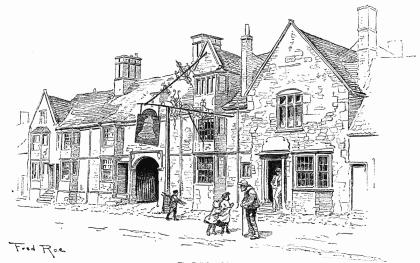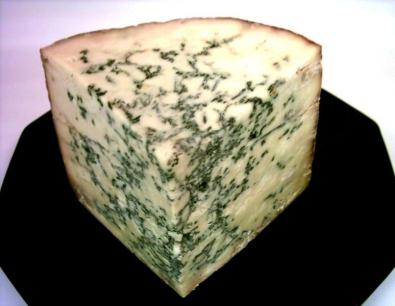

|
 A medium texture blue veined moulded cheese made in cylindrical form from full cream cow’s milk with no added pressure, with blue penicillium veins radiating from the centre, and forming its own crust. There is a 19th Century receipt for the basic cheese under White Stilton  The ‘Bell Inn’ at Stilton From ‘Vanishing England‘ 1910 It has long been known that Blue Stilton Cheese was historically supplied from the Bell Inn in the village of Stilton, and it is known that a cheese of some sort has been made in Stilton from ancient times, but it has not always been clear whether the blue version was first, or ever, made there.  Blue Stilton Photo: Dominik Hundhammer Daniel Defoe, in his ‘A tour thro’ the whole island of Great Britain‘ of 1724-27 has; “we pass’d Stilton, a town famous for cheese, which is call’d our English Parmesan, and is brought to table with the mites, or maggots round it, so thick, that they bring a spoon with them for you to eat the mites with, as you do the cheese.”  Original Receipt in Richard Bradley’s ‘A general treatise of husbandry & gardening‘ of 1726 Original Receipt in Richard Bradley’s ‘A general treatise of husbandry & gardening‘ of 1726Stilton is in Lincolnshire in the Coach Road to Lincoln from London where at the Sign of the Bell is much the best Cheese in Town the Man of that House keeping strictly to the old Receipt While others thereabouts seem to leave out a great part of the Cream which is the chief Ingredient but for all this the Name this sort of Cheese has got above others makes it sell for 12d per Pound upon the Spot Receipt to make Stilton Cheese TAKE ten Gallons of Morning Milk and five Gallons of sweet Cream and beat them together then put in as much boiling Spring water as will make it warmer than Milk from the Cow when this is done put in Runnet made strong with large Mace and when it is come or the Milk is let in Curd break it as small as you would do for Cheese Cakes and after that salt it and put it into the vatt and press it for two Hours Then boil the Whey and when you have taken off the Curds put the Cheese into the Whey and let it stand half an Hour then put it in the Press and when you take it out bind it up for the first Fortnight in Linen Rollers and turn it upon Boards for the first Months twice a Day Prof. R Bradley (Bradley 1728) says that; “As for the famous Stilton Cheese, which I have already published the Receipt of, we are to make the Rennet strong of Mace, by boiling the Mace in the Salt and Water, for without that is done, the Cheese will not have the true Relish that the first famous Stilton Cheeses had; and without the People of Stilton keep up the antient way of making it, agreeable to the old Receipt, they must of necessity lose the Reputation they have gain’d by their Cheeses. I shall not pretend to affirm why the Cheeses now in that Town are not generally so good as they were formerly; but perhaps it is because some of the Cheese-Sellers there depend upon the reputation of the first Cheeses, and now buy Cheeses from other parts, where nothing of the true Receipt is known but the Figure. However, it would be injustice in me if I did not take notice, that the Master of the Blue-Bell Inn in Stilton provided me with one that was excellent in its way, and yearly furnishes as many Customers with them as give him timely Notice: But as these Cheeses require time in the Dairy, before they are fit for eating, and the Season of making them is in the Bloom of the Year, so it is necessary to speak for them betimes, to have them to one’s mind.” But, in the 1807 ‘The Beauties of England and Wales‘ by John Britton we are told; “It is asserted by Mr. Marshall, in his Agricultural Work, on the ‘Midland Counties,’ that Mrs. Paulet, of Wymondham, near Melton-Mowbray, was the first person who manufactured this sort of cheese; but other dairywomen lay claim to priority. However, it is known, that Mrs. P. was a relation, or intimate acquaintance, of the well-known Cooper Thornhill, who formerly kept the Bell-Inn, at Stilton, and that she supplied that house with peculiar and novel sort of cheese, which obtained much celebrity, and was frequently retailed by the landlord at half a crown per pound. From the place of sale, therefore, it certainly acquired its distinctive name.” Receipts for making Stilton appear in ‘Midland Department‘ by William Marshall (1818), who also gives, under the heading “Another history of Stillon Cheese” (p436). “After copying the account of Mr Nichols in his ‘History and Antiquities of the County of Leicester’ the Reporter proceeds p 232 “but Mr John Pitts landlord of the Bell Inn Stilton as well as Mr Maxwell contend with the the greatest probability of truth that the famous Stilton cheese was first made at Stilton in Huntingdonshire.” Mr Pitts reasons for maintaining that opinion are given in the following account drawn up from Mr Pitts own relation of the case. Mr John Pitts, landlord of the Bell Inn at Stilton, says that he has every reason to believe that the cheese known under the name of Stilton was originally made at that place, that one Croxton Bray a very old man who died about the year 1777 aged about eighty years, remembers very well when a boy that he his brothers and sisters and the people of Stilton in general sent their children about to collect all the cream in the neighbouring villages for the purpose of making what is called Stilton cheese. The receipt for making it is the cream of the evening and morning and the new milk all mixed together. This must have been long before Mr Cooper Thornhill’s time. Mr Thornhill selling great quantities and wanting more than could be had at Stilton and knowing that Leicestershire produced excellent milk and having relations in that county he sent in person to them to instruct them io the mode of making it.” An EU protection of the Stilton Cheese name has been obtained by a consortium of the major producers, so that it is now required by law to be manufactured only in the counties of Derbyshire, Nottinghamshire and Leicestershire from locally produced pasteurised milk. This means that it is illegal to manufacture Stilton Cheese in Stilton, which is now in Cambridgeshire. It is equally illegal to manufacture Stilton using the traditional unpasteurised milk, which has led to the appearance of the extraordinarily similar Stichelton blue cheese. The village of Stilton holds a cheese-rolling festival each May. See: Belvoir Crumpets Creamed Broccoli Soup Shropshire Blue Stichelton Cheese Stilton and Celery Soup Stilton Mash Stilton Pears Stilton Soup Stilton Steak White Stilton Yorkshire-Stilton  |
|
MORE FROM Foods of England... Cookbooks ● Diary ● Index ● Magic Menu ● Random ● Really English? ● Timeline ● Donate ● Royalty ● English Service ● Food Map of England ● Lost Foods ● Accompaniments ● Biscuits ● Breads ● Cakes and Scones ● Cheeses ● Classic Meals ● Curry Dishes ● Dairy ● Drinks ● Egg Dishes ● Fish ● Fruit ● Fruits & Vegetables ● Game & Offal ● Meat & Meat Dishes ● Pastries and Pies ● Pot Meals ● Poultry ● Preserves & Jams ● Puddings & Sweets ● Sauces and Spicery ● Sausages ● Scones ● Soups ● Sweets and Toffee ● About ... ● Bookshop ● Email: [email protected] COPYRIGHT and ALL RIGHTS RESERVED: © Glyn Hughes 2022 BUILT WITH WHIMBERRY |